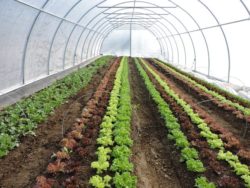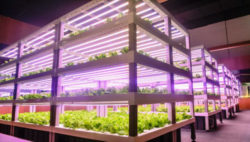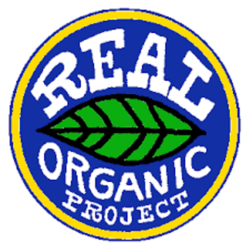Read Time: 4 Minutes Subscribe & Share
Dissension In The Ranks
 I started following The Real Organic Project shortly after I began writing Kitchen Detail. Phil Barrows of San Giovanni Farms pulled me over one morning at the Old Town Farmers Market, and suggested that I educate myself and write about the differences between hydroponic and organic farming. Hydroponic growers wanted to use the lucrative term “certified organic” on their retail labels. The USDA has allowed this labelling, much to the outrage and protest from organic organizations, as well as from individual farmers who have spent years cleaning and revitalizing soil on their properties to qualify for the coveted label.
I started following The Real Organic Project shortly after I began writing Kitchen Detail. Phil Barrows of San Giovanni Farms pulled me over one morning at the Old Town Farmers Market, and suggested that I educate myself and write about the differences between hydroponic and organic farming. Hydroponic growers wanted to use the lucrative term “certified organic” on their retail labels. The USDA has allowed this labelling, much to the outrage and protest from organic organizations, as well as from individual farmers who have spent years cleaning and revitalizing soil on their properties to qualify for the coveted label.
Hydroponics to me is a perfectly legitimate way to grow certain crops – basically, you are giving them a water bath of nutrients, which, along with sunlight or (more often) grow lights, produces the fruit or vegetable of choice. You also have to maintain a certain humidity and temperature level, so hydroponic crops are not money-savers on a large scale. If you buy hydroponic and soil-grown produce, which I do, you will notice that there exists a difference in flavor and texture. Hydroponics certainly can give you a lush looking tomato that has not been doused in toxic chemicals. But it will not have the flavor of a field grown orb, and even among field grown ones, my experience has been that organically grown tomatoes taste better. Not all farmers who grow crops organically are in the USDA Certified Organic register. Many become discouraged by the expense and the competition with agribusiness that is organic in name only. The certification process takes several years to complete.
them a water bath of nutrients, which, along with sunlight or (more often) grow lights, produces the fruit or vegetable of choice. You also have to maintain a certain humidity and temperature level, so hydroponic crops are not money-savers on a large scale. If you buy hydroponic and soil-grown produce, which I do, you will notice that there exists a difference in flavor and texture. Hydroponics certainly can give you a lush looking tomato that has not been doused in toxic chemicals. But it will not have the flavor of a field grown orb, and even among field grown ones, my experience has been that organically grown tomatoes taste better. Not all farmers who grow crops organically are in the USDA Certified Organic register. Many become discouraged by the expense and the competition with agribusiness that is organic in name only. The certification process takes several years to complete.
Organic For Real
 The Real Organic Project grew out of frustration with the USDA for allowing its organic certification program to include rogue players in the field of organic agriculture. One example is the falsely certified organic soy and corn shipped from other countries – Turkey is a big offender. US farmers cannot supply enough “organic” grain to feed the beef cattle, hogs, sheep and chickens so they can bear the vaunted and more profitable label. Through massive lobbying by what is now less than a handful of food conglomerates, USDA has allowed these huge companies the license to use the USDA Certified organic label even if the poultry or herds are housed and raised in circumstances that evade organic principles. Another dodge that’s allowed is the term “made with certified organic ingredients”. Since its founding in 2018, ROP has registered over a thousand legitimate organic farms, and you can use its register to locate one in your state. Their trustworthy certification label is becoming more visible to organic food shoppers.
The Real Organic Project grew out of frustration with the USDA for allowing its organic certification program to include rogue players in the field of organic agriculture. One example is the falsely certified organic soy and corn shipped from other countries – Turkey is a big offender. US farmers cannot supply enough “organic” grain to feed the beef cattle, hogs, sheep and chickens so they can bear the vaunted and more profitable label. Through massive lobbying by what is now less than a handful of food conglomerates, USDA has allowed these huge companies the license to use the USDA Certified organic label even if the poultry or herds are housed and raised in circumstances that evade organic principles. Another dodge that’s allowed is the term “made with certified organic ingredients”. Since its founding in 2018, ROP has registered over a thousand legitimate organic farms, and you can use its register to locate one in your state. Their trustworthy certification label is becoming more visible to organic food shoppers.
ROP recently partnered with Naturland in Germany, a 40-year-old organization that has registered over 140,000 farms that meet its requirements. Naturland and Real Organic Project plan to accept each other’s certification and create broader marketing opportunities for their members. Naturland has broader goals and is in line with the Regenerative Agriculture movement in the US – in its scope, it includes social justice and standards for farm workers and protection of children – an area that has suffered some chilling losses in the US recently.
registered over 140,000 farms that meet its requirements. Naturland and Real Organic Project plan to accept each other’s certification and create broader marketing opportunities for their members. Naturland has broader goals and is in line with the Regenerative Agriculture movement in the US – in its scope, it includes social justice and standards for farm workers and protection of children – an area that has suffered some chilling losses in the US recently.
Our Wallets, Our Power
This seems like a good time to rally consumer troops to pay more attention to how they spend their ammunition – which is their grocery money. Since I have stepped away from buying groceries in the US and have been stumbling through buying them in Bologna and elsewhere we visit in Italy, I have seen some remarkable differences in choices. The choices in one way are narrower here, but then the standards and legislation are stricter than in the US. As of this moment in the EU, hydroponic produce cannot carry an organic label. Yet there is a greater percentage of organic agriculture in the EU than exists in the US. Italy’s percentage is over 17% while in the US it is less than 1%.
As I said in an earlier post, within three months we noticed a positive change in our overall health. And it was not that we didn’t shop for food from local sustainable and organic producers in Alexandria. I still think that MOM’s walks the walk as an organic grocery store, much more than Whole Foods does. And we shopped weekly at two local Farmers Markets. But still… we did not in any way go the route of Barbara Kingsolver in her very revealing book Animal, Vegetable, Miracle: A Year Of Food Life.
That’s why I think this video of the speech given at a Real Organic Project conference is such a good wake-up call. We have power as consumers, but it is a power that needs to be more of a conscious discipline than making a poster for a demonstration or signing a petition – all very good things to do – but money talks. I think you’ll find that there are other useful, conscience-twinging consumer encouragements in this excellent speech from Kristin Kimball a 20-year farmer and author of two books (Good Husbandry: A Memoir and The Dirty Life: On Farming Food and Love). She also offers a parental and social prod having nothing to do with food per se — the dearth of real versus simulative experiences we offer to our children. As she says quite eloquently, organic farmers have done enough, the rest is up to us.

Kitchen Detail shares under the radar recipes, explores the art of cooking, the stories behind food, and the tools that bring it all together, while uncovering the social, political, and environmental truths that shape our culinary world.





Comments are closed here.
Follow this link to create a Kitchen Detail account so that you can leave comments!